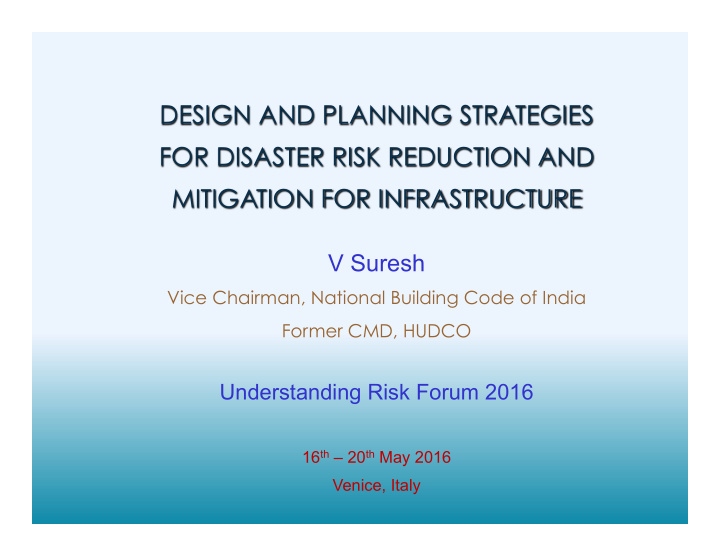



DESIGN AND PLANNING STRATEGIES FOR DISASTER RISK REDUCTION AND MITIGATION FOR INFRASTRUCTURE V Suresh Vice Chairman, National Building Code of India Former CMD, HUDCO Understanding Risk Forum 2016 16 th – 20 th May 2016 Venice, Italy
Urbanisation Scenario in India Decadal Growth Rate of Popula3on (1991-2001) Urban: 31.13% Rural: 17.97% ü 350 Million ge3ng added in 2 Decades ü Extremely suscep?ble to Natural Hazards and aCendant disasters 1500 Total Urban 1350 M 1200 11 May, 2000, 1000 M 900 540 M 393 600 (40%) (33%) 285.35 217.61 361 (28%) 330 M (25.71%) 300 62(17%) 50 M (16%) 0 1947 1951 1961 1971 1981 1991 2001 2011 2021
COSTS OF DISASTERS Kobe earthquake registered a record damage of • US$ 190 Billion. • Only one person died (that too of heart attack) in the earthquake at Seattle in Feb. 2001 whereas in the Gujarat earthquake of January 2001 of the same intensity 13,500 died and over 0.8 million houses were damaged partly or fully – due to strong pre-disaster mitigation efforts in Seattle – a clear pointer for effective Building Code Enforcement. • The socio-economic cost of such disasters are much higher and difficult to estimate and have long-term repercussions on societies, irrespective of the degree of development of the countries.
EMERGING NEED FOR PARADIGM SHIFT IN FOCUS Prediction, Preparedness, Prevention, Planning, Protection Promotion, Publicity, Participation & Partnership for or Pre-D e-Dis isas aster er Mit itiga igation ion AS AGA GAINS NST Pos ost -D -Dis isas aster er init initia iativ ives es for or Res escue, cue, Reco ecover ery, , Relief elief, , Reha ehabilit bilitation, ion, Recons econstruct uction, ion, Repair epair, , Renew enewal al & Ret etrof ofit itting ing
PROMOTING SAFER BUILDINGS/CONSTRUCTION To ensure massive financial resource investments for housing and other public asset buildings and infrastructure are safe, strong, durable and perform well during their life cycle you need to protect against: Cyclones/ Floods Earthquakes Typhoons Land slides Sea erosion/Tsunamis
PROMOTING SAFER BUILDING CONSTRUCTION Three critical elements for action areas to promote safer building construction are in creating : Awareness Appreciation Application
AWARENESS Most communities are unaware of vulnerability of neighbourhood to disasters (wind-prone, flood basin, seismic zone, landslide zone) or proneness of the area to one/multiple hazards. • Lack of organised hazard-based risk assessment for indicating – Mapping for the same – Vulnerability Atlas (Japan, Sri Lanka, India) • Awareness to permeate at the level of: – Community / Beneficiary families – Practicing professionals – Building construction / Delivery groups – Building regulatory systems
APPRECIATION LACK OF APPRECIATION: • On safe locations (prohibited sites and restricted sites with precautionary limitations) • On efficacy in the use of ‘safe’ and ‘time tested’ traditional/ technological construction practices providing for desired response / resistance to disaster induced forces / action / effects • On the need to ensure effective quality control measures during construction / execution stages or the disastrous implications thereof
APPLICATION • Safer building construction practices with disaster resistant/ protected planning, design and construction features would need to create enabling environment for application of all norms for safety namely: – Structural Safety – Public Safety – Life Safety – Construction Safety • These can be ensured by adopting many action areas for application.
IMPERATIVES FOR DISASTER RESISTANT INFRASTRUCTURE / BUILDING • EDUCATION – Creating awareness among general public use of audio-visual media [Demand Side] – Awareness among students of technical institutions Upgradation of curricula [Supply side] – Capacity building of the concerned agencies/ administrators – To reform the building and infrastructure delivery system, it is essential to provide training for the contractors, supervisors and master masons and workers in disaster resistant construction
NBC OF INDIA 2016 Built around the philosophy of creating and maintaining a Safe Built Environment for people and property by ensuring: 2016 Structural version Safety Public Health Safety Safety Life Fire Safety Safety Environment Construc?on Safety Safety Electric Safety
ENFORCEMENT To mandatorily associate the right level of professionals (architects, engineers, structural engineers, supervisors) of degree/ diploma or certificate level depending on: • The nature of building / infrastructure (type, size, area, height) • The location (mega /metro city, medium/ small town and villages)
MAINTENANCE AND ASSET MANAGEMENT • Creating safe assets for disaster mitigation is important (CAPEX) • Equally important is to evolve appropriate maintenance and asset management strategies and actions (OPEX) for ensuring safe and long term life and continuous functional performance of the infrastructure / buildings – to combat obsolescence, decay and disfunctioning • Calls for inspection systems at periodic intervals and carrying out non- structural / structural upkeep, maintenance and repairs and “unsafe” buildings and infrastructure to be retrofitted • Including Periodic Renewal Clearances – against “Safety concerns”
TOWARDS SUSTAINABLE AND SAFE BUILT ENVIRONMENT ... . Thank you for your kind attention
Recommend
More recommend